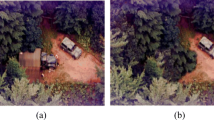Abstract
Local correlation pattern indicates integrity of an image. Exposing digital forgeries by detecting local correlation pattern of images has become an important kind of approach among many others. However, local correlation pattern is sensitive to JPEG compression, since compression can be regarded as a local homogenization and attenuates the characteristics of local correlation pattern. In this paper, rather than concentrating on the differences between image textures which is common in previous works, we specifically build a gaussian model to describe the local-correlation pattern of color filter array (CFA) interpolation. Thus the model will automatically adapt to JPEG compression. With the model built from the test image, the posterior probability map of CFA interpolation is calculated. To measure the trace of CFA, frequency characteristics of the posterior probability map are calculated and weighted combined. Then the image is classified as tampered or not by a simple threshold. Experimental results from over thousands of tampered images show the validity and efficiency of the proposed method. Moreover, we examine our algorithm to the problem of distinguishing computer-generated images from photos and detecting local tamper area. The proposed method shows a good performance in these tests.

















Similar content being viewed by others
References
Cao G, Zhao Y, Ni R, Tian H (2010) Anti-forensics of contrast enhancement in digital images. In: Proceedings of the 12th ACM workshop on multimedia and security, pp 25–34
Stamm MC, Liu KJR (2011) Anti-forensics of digital image compression. IEEE Trans Inf Forensics Secur 6(3):1050–1065
Katzenbeisser S, Petitolas F (1999) Information hiding techniques for steganography and digital watermaking, 1st edn. Artech House, p 240, 10/1999 - ISBN: 1580530354
Cox I, Miller M, Bloom J, Honsinger C (2002) Digital watermarking. J Electron Imaging 11(3):414–414
Lu W, Varna AL, Wu M (2010) Forensic hash for multimedia information. SPIE Media Forensics and Security, pp. 7541–0Y
Battiato S, Farinella GM, Messina E, Puglisi G (2012) Robust image alignment for tampering detection. IEEE Trans Inf Forensics Secur 7(4):1105–1117
Farid H (2009) A survey of image forgery detection. IEEE Signal Process Mag 2:16–25
Mahdian B, Saic S (2010) A bibliography on blind methods for identifying image forgery. Signal Process Image Commun 25(6):389–399
Redi JA, Taktak W, Dugelay JL (2011) Digital image forensics: a booklet for beginner. Multimed Tools Appl 51(1):133–162
Fridrich J, Soukal D, Lukáš J (2003) Detection of copy-move forgery in digital images. In: Proceedings of digital forensic research workshop
Popescu AC, Farid H (2004) Exposing digital forgeries by detecting duplicated image regions. Dartmouth College Tech. Rep, TR2004-515
Mahdian B, Saic S (2007) Detection of copy-move forgery using a method based on blur moment invariants. Forensic Sci Int 171(2):180–189
Lukáš J, Fridrich J, Goljan M (2006) Detecting digital image forgeries using sensor pattern noise. In: Proceedings of SPIE 6072, pp 362–372
Hsu YF, Chang SF (2010) Camera response functions for image forensics: an automatic algorithm for splicing detection. IEEE Trans Inf Forensics Secur 5(4):816–825
Popescu AC, Farid H (2005) Exposing digital forgeries by detecting traces of resampling. IEEE Trans Signal Process 53(2):758–767
Popescu AC, Farid H (2005) Exposing digital forgeries in color filter array interpolated images. IEEE Trans Signal Process 53(10):3948–3959
He J, Lin Z, Wang L, Tang X (2006) Detecting doctored JPEG images via DCT coefficient analysis. ECCV 2006, pp 423–435
Farid H (2009) Exposing digital forgeries from JPEG ghosts. IEEE Trans Inf Forensics Secur 4(1):154–160
Battiato S, Messina G (2009) Digital forgery estimation into DCT domain: a critical analysis. In: Proceedings of the first ACM workshop on multimedia in forensics 2009, pp 37–42
Zach F, Riess C, Angelopoulou E (2012) Automated Image Forgery Detection through Classification of JPEG Ghosts. Pattern Recognition 2012, pp. 185–194
Johnson MK, Farid H (2005) Exposing digital forgeries by detecting inconsistencies in lighting. In: Proceedings of the 7th workshop on multimedia and security, pp 1–10
Johnson MK, Farid H (2007) Exposing digital forgeries in complex lighting environments. IEEE Trans Inf Forensics Secur 2(3):450–461
Gallagher AC, Chen T (2008) Image authentication by detecting traces of demosaicing. CVPRW’08, pp 1–8
Dirik AE, Memon N (2009) Image tamper detection based on demosaicing artifacts. ICIP’2009, pp 1497–1500
Swaminathan A, Wu M, Liu KJR (2007) Nonintrusive component forensics of visual sensors using output images. IEEE Trans Inf Forensics Secur 2(1):91–106
Cao H, Kot AC (2009) Accurate detection of demosaicing regularity for digital image forensics. IEEE Trans Inf Forensics Secur 4(4):899–910
Fan N, Jin C, Huang Y (2009) A pixel-based digital photo authentication framework via demosaicking inter-pixel correlation. In: Proceedings of the 11th ACM workshop on multimedia and security, pp 125–130
Kirchner M (2010) Efficient estimation of CFA pattern configuration in digital camera images. In: Proceedings of SPIE, the International Society for Optical Engineering
Takamatsu J, Matsushita Y, Ogasawara T, Ikeuchi K (2010) Estimating demosaicing algorithms using image noise variance. In: IEEE conference on computer vision and pattern recognition (CVPR), 2010, pp 279–286
Schaefer G, Stich M (2004) UCID—an uncompressed colour image database. In: Proceedings SPIE, storage and retrieval methods and applications for multimedia 2004, San Jose, USA, pp 472–480
Ng TT, Chang SF, Hsu J, Pepeljugoski M (2004) Columbia photographic images and photorealistic computer graphics dataset. Columbia University, ADVENT Technical Report, pp 205–2004
Raph. http://www.raph.com. Accessed 28 March 2011
3dtotal. http://www.3dtotal.org. Accessed 28 March 2011
Renderosity. http://www.renderosity.com. Accessed 28 March 2011
Creative Crash. http://www.creativecrash.com. Accessed 28 March 2011
3dlinks. http://www.3dlinks.com/. Accessed 28 March 2011
Acknowledgments
This work was supported by the National Basic Research Program of China (973 Program) under Grant No. 2012CB316400, Specialized Research Fund for the Doctoral Program of Higher Education (SRFDP) (No. 20090201110029), the National Natural Science Foundation of China under Grant Nos. 61273252 and 61075007.
Author information
Authors and Affiliations
Corresponding author
Rights and permissions
About this article
Cite this article
Li, L., Xue, J., Wang, X. et al. A robust approach to detect digital forgeries by exploring correlation patterns. Pattern Anal Applic 18, 351–365 (2015). https://doi.org/10.1007/s10044-013-0319-9
Received:
Accepted:
Published:
Issue Date:
DOI: https://doi.org/10.1007/s10044-013-0319-9




